On the Road: Kelly Clark says to slow down and enjoy the culture

Don’t worry about the time on the clock. Olympic snowboarder Kelly Clark tells Edge that it's worth the extra effort to take in the local culture, even when the comforts of your hotel room are calling out to you.
“If I’m passing through Tokyo for the night, I get up and go to the fish market in the morning, even if it is 3 a.m.,” she says. “I used to do a lot less [going out]. I was kind of missing it. People would ask me what I saw and I what I saw was my hotel room. These last few years I have tried to get out and see things. It is awesome to see places.”
- MORE EDGE: Walking 430 miles in the Yukon Arctic Ultra
While Clark does do a little research to make the most of each of her trips, that work is just another part of her overall plan to simplify her travel, and it never interferes with her mental focus, nutrition or even her packing.
“When I’m traveling for a snowboard competition, that is what I’m traveling for,” she says. “That is what is on my mind. I am there to focus on snowboarding.”
Clark spends time off the slopes working on video review, re-watching runs from the day to learn where she wants her snowboard to be, making herself as prepared as she can. As the event draws near, her focus intensifies. “I’m not really talkative,” Clark confesses,” I get so wrapped up in my task for the next day. I’ve already stepped away from other things to focus.”
Book excerpt: Exploring the dangers of World Cup ski racing
With her mind focused on the sport, nutrition comes simply too. Clark isn’t a strict eater; she has no defined guidelines. But she eats healthy—which can actually be easy where she visits. “Where I get to travel to is a lot of mountain towns and resort destinations, so I find incredible restaurants,” she says. “I get to eat some amazing food. When I traveled to Japan I was getting to experience a Korean barbecue and in Austria, local schnitzel. I’m always trying to eat local food and delicacies.”
She also has “every women’s wish,” she says, in that participating in such an active sport has her struggling to eat enough. Clark totes an entire box of snack bars with her, stashed in every pocket of every suitcase, backpack and travel bag. “I constantly have access to food when I’m training,” she says. “It goes a long way to staying out of the red zone.”
During the snow season, Clark spends little time at home, often only four days a month. Nonconsecutive days, mind you. In January, she was home two days. She’ll have two more days in February at home, hitting up to five locations in a four-week stretch. All that movement makes packing a chore.

“I learned to simplify things,” she says. Using Burton travel bags—“not just because I represent them, they make some of the best travel bags in the business”—she brings two to three boards everywhere she goes (technical support folks from the U.S. team bring an additional six), backup bindings and more equipment. She loads all her snowboard gear in a snowboard bag and then brings one large duffel bag and one large backpack. That’s only three bags for a month-long trip.
Clark will pack those bags in November and keep them packed until April, even when she is home for the short breaks. “The fewer bags you have, the better off you are,” she says. “If you can pack those few bags really well.”
When she acquires items on the road, she doesn’t worry about the extra space in her packs. She has found it much cheaper to simply ship back the extra items instead of paying the extra baggage fee. Plus, as she points out, it makes travel a lot easier.
Inspired by others and by her own near tragedy, a snowboarder steps up
Committed to pre-packing, Clark plans out her competition outfits early. She generally brings two snowpants and up to three coats, making sure all pants go with all coats. “I’m making sure every color has a multiple purpose so I can mix and match,” she says. “It makes it more versatile. That is what you want to think about when packing. What can you bring that you can wear for every occasion—sweatshirts that are comfortable to hang out in, but nice enough to out to dinner in as well. You want to make sure you can pack your bags with as many purposes in mind.”
Traveling as much as 120,000 miles per season, Clark puts her fitness focus on maintenance during the season and on gaining strength and building in the summer. In one of her suitcases, Clark carries a collapsible case with resistance bands, jump ropes, a small set of cones, a heart rate monitor and a stretch stick.

“I can get a workout done anywhere,” she says. At a hotel, as long as it is at least four stories, she says, she’ll do stairs—“you can get a great workout in there”—and look for her at a kids’ playground.
“I’m looking for parks to put my feet on swings and do TRX,” she says. “You can do full body weight circuits on a jungle gym and run cones in the park. I have to get creative and adjust.” Of course, you mustn’t mind the stares from the locals.
All this intense focus isn’t without some mental breaks too, whether watching a movie, pounding out some guitar chords—Clark travels with a small guitar—reading on her Kindle or hitting the Tokyo fish market. You never know what cultural memory you’ll make, even at 3 a.m.
Tim Newcomb covers stadiums, design and gear for Sports Illustrated. Follow him on Twitter at @tdnewcomb.
